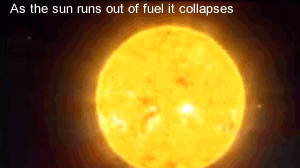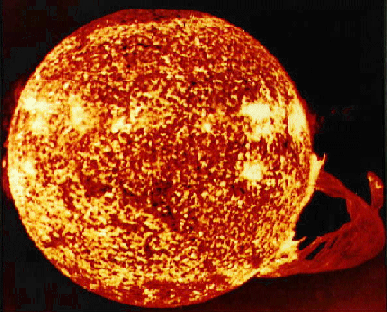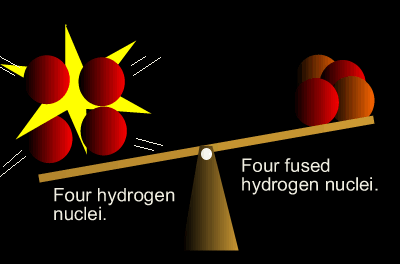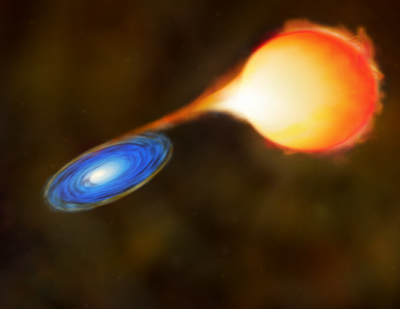Annihilation
by the Sun.
Another hazard that plaques our
planet is our very own sun.
|
Our
Sun contains an extraordinary amount of mass which creates gravitational
forces large enough to keep the Sun from expanding violently due to the
heat. In fact 98% of the total mass of the solar system is in the Sun. The
Sun's outer layer has a temperature of 5,700°C. Deep in the core of
the Sun solar energy is created at temperatures of 15,000,000° C. At
such high temperatures violent nuclear reactions take place.
|
|
| These
reactions involve the fusion of four hydrogen nuclei to form one helium
nucleus, as shown on the right. If we were to put the helium nucleus on
a very sensitive electronic balance we would find that it is about 0.7%
less massive than the four hydrogen nuclei. The difference in mass is expelled
as solar energy largely in the form of light and heat. Every second 700
million tons of hydrogen are converted into helium of which 0.7% of this
is converted into pure energy according to the equation put forward by Einstein,
E = mc2. This equation simply states that mass can be converted
to energy, where m is mass and c is the speed of light. As the Sun ages
it gets lighter as more mass is converted into energy and radiated our into
space.. |
|

|
The
Sun is 4.6 billion years old and contains enough hydrogen to go on for
another five billion years. As the Sun gets older it will get lighter
and will run out of hydrogen, at which point helium will start to fuse
together to form heavier elements. However, running out of fuel doesn't mean it will get colder. As stars run out of hydrogen they actually get hotter.
As the hydrogen runs out, the Sun will cool and collapse in on itself. This will once again heat up the inner core to millions of degrees and create the right conditions for helium to start fusing together to form heavier elements. During this phase the Sun will start
to swell into a red giant and engulf Mercury, Venus and may be Earth.
Venus and Mercury will most certainly be vapourised, but even if Earth
survives being engulfed it will suffer a horrible fate. It will be reduced
to a barren, lifeless landscape devoid of water and atmosphere. After
a billion years it will end its life as a red giant and suddenly collapse
into a white dwarf where it will take a trillion years to cool.
|
| But how can
we predict with any certainty the fate of our Sun? The answer is astronomy.
A group of stars in our galaxy, the Milky Way, have captured the interest
of astronomers for more than 400 years, This group of stars, known as
Mira stars are red giants and represent older versions of Sun-like stars.
So what we observe is a foreshadowing of the Sun's own fate in approximately
5 billion years. Mira stars eject large amounts of gas and dust into space
and have a shell composed of vapour that, if in the same location as our
own Sun, would reach beyond Mars. A highly
evolved red giant star, and Mira B (left), a white dwarf. Mira A is losing
gas rapidly from its upper atmosphere while Mira B exerts a gravitational
force that sucks the gases into it.
An
X-ray image of two Mira stars is shown on the right. Mira A (right),
|
|
| What
is happening to the mass of the Sun as it gets older?
Explain why.
Why will the Sun grow into a red giant as it runs out of fuel (hydrogen)?
Where does the energy given off by the Sun come from?
Why will Earth
lose its atmosphere and water as the Sun expands into a red giant?
What mass of
fuel is converted into energy every second in our Sun?
How do astronomers
predict with accuracy the future of our Sun?
|
|



